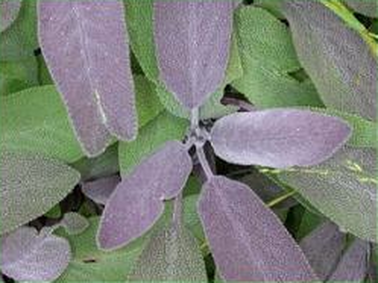
Sage has been praised throughout history and on many continents for its powers of longevity. The name salvia, from the Latin salve, means to be in good health, to cure or to save. To the Romans it was a sacred herb gathered with ceremony.
Sage can be used in a number of ways : culinary, medicinal, garden design and dried arrangements. It can be grown from seed or purchased plants. Whichever you do, consider the intended use to help decide quantity. Two plants of garden sage will probably supply all of your culinary needs but you may want larger quantities of purple and/or tri-color sage to use in borders. Use new seed each year as sage quickly loses its viability. Sow seeds directly in the ground or start 6-8 weeks before the last frost. Pressed seeds in moist soil will germinate in 4-12 days at 70-85 degrees. Plant seedlings outdoors after the last frost in well drained, rich soil in full sun. Space seedlings 18-24 inches apart. Cut back mature plants to growing points to encourage fresh growth. It is a short -lived perennial. Harvest leaves before the flowers open. The sage leaves dry very well by hanging in small bunches. Once dry, store away from light.
Culinary uses:
In many parts of Canada sage replaces our traditional uses of summer savory in New Brunswick. It is mixed with onion for poultry stuffing as well as with rich fatty foods like pork, duck and sausage. It is valuable as an aid to digesting these fat foods which may be one of its major health benefits. We use whole dried or fresh leaves on a roast pork as well as in a dried end of the season herb mix on any kind of roast. The blossoms are an attractive addition to salads so you may want to let one of your plants go to bloom. Try some of our delicious recipes for sage:
Grilled Mustard Sage Pork and Zucchini
Roasted potatoes with Sage
Dried Arrangements:
Dried leaves retain their shape very well and small bunches are great in herbal wreaths and swags. The purple sage has a deep color that mixes well with many others, providing a background richness to any wreath.
Garden Design:
Sage is design plant whose virtues are often overlooked. The purple sage, in particular, has large leaves that fill in a border for the whole growing season. Its color is magnificent !! Variations in effect can be achieved by co-coordinating groupings of purple or tri-colour sage with other herbs or flowers.
Medicinal Uses:
There are many ancient sayings about sage. A Latin proverb translates " how can a man die when sage grows in his garden"? Early herbalists believed sage calmed the nerves, alleviated nervous headaches and soothed sore throats. It should be avoided by pregnant and lactating women. Sage tea is still recommended for sore throats. Cover one teaspoon dried or fresh chopped leaves with one cup of boiling water. Steep 10 minutes. Strain and sweeten with honey.
Sage can be used in a number of ways : culinary, medicinal, garden design and dried arrangements. It can be grown from seed or purchased plants. Whichever you do, consider the intended use to help decide quantity. Two plants of garden sage will probably supply all of your culinary needs but you may want larger quantities of purple and/or tri-color sage to use in borders. Use new seed each year as sage quickly loses its viability. Sow seeds directly in the ground or start 6-8 weeks before the last frost. Pressed seeds in moist soil will germinate in 4-12 days at 70-85 degrees. Plant seedlings outdoors after the last frost in well drained, rich soil in full sun. Space seedlings 18-24 inches apart. Cut back mature plants to growing points to encourage fresh growth. It is a short -lived perennial. Harvest leaves before the flowers open. The sage leaves dry very well by hanging in small bunches. Once dry, store away from light.
Culinary uses:
In many parts of Canada sage replaces our traditional uses of summer savory in New Brunswick. It is mixed with onion for poultry stuffing as well as with rich fatty foods like pork, duck and sausage. It is valuable as an aid to digesting these fat foods which may be one of its major health benefits. We use whole dried or fresh leaves on a roast pork as well as in a dried end of the season herb mix on any kind of roast. The blossoms are an attractive addition to salads so you may want to let one of your plants go to bloom. Try some of our delicious recipes for sage:
Grilled Mustard Sage Pork and Zucchini
Roasted potatoes with Sage
Dried Arrangements:
Dried leaves retain their shape very well and small bunches are great in herbal wreaths and swags. The purple sage has a deep color that mixes well with many others, providing a background richness to any wreath.
Garden Design:
Sage is design plant whose virtues are often overlooked. The purple sage, in particular, has large leaves that fill in a border for the whole growing season. Its color is magnificent !! Variations in effect can be achieved by co-coordinating groupings of purple or tri-colour sage with other herbs or flowers.
Medicinal Uses:
There are many ancient sayings about sage. A Latin proverb translates " how can a man die when sage grows in his garden"? Early herbalists believed sage calmed the nerves, alleviated nervous headaches and soothed sore throats. It should be avoided by pregnant and lactating women. Sage tea is still recommended for sore throats. Cover one teaspoon dried or fresh chopped leaves with one cup of boiling water. Steep 10 minutes. Strain and sweeten with honey.
